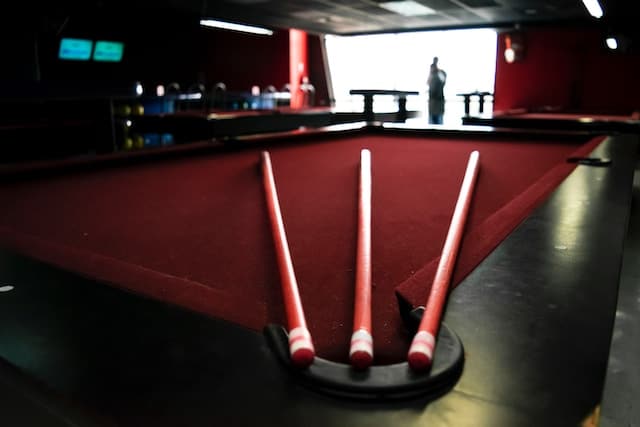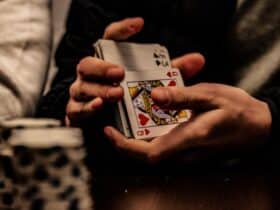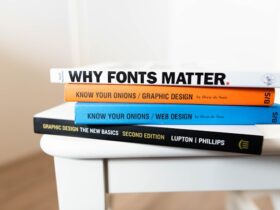There are several factors to consider when buying a new pool set in terms of size. There ought to be enough space for players to fire on every side of the table, even if it fits snugly inside the space.
You should think about the size of the cues you want to utilize and if adults or kids will be using the table. Additionally, you might need space for a cabinet or rack to hold extra cues and balls.
Size Chart for Pool Table Room
The 8′ tables (8′ × 4′) are typically regarded as “professional” size, whereas 7′ tables (7′ x 3’6″) are regarded as “bar” size. If they have the room, most pool table purchasers would choose the bigger model since it offers a more enjoyable playing experience.
Not only is a 7′ table more appropriate for smaller spaces, but if you frequently play pool in bars, you might prefer to practice at home on a field that is the same size. Should the pool table be located in the cellar, you must take into account any support beams or poles that might hinder play.
The table’s breaking end ought to be placed far from the support structure so that the beam causes the least amount of disruption to play. Although it’s not the most conventional arrangement, some owners of pool tables place their tables near to the center of a side rail.
Bank Shots
In addition to being amazing to behold, bank shots are a crucial tool in the toolbox of every skilled pool player. When there are no other shots available, they are actually vital to the game.
It needs perseverance, practice, and a foundational knowledge of geometry and physics to master them. The easiest way to think about bank shots is to visualize equal angles.
A target ball hit at one angle should, in principle, rebound off the side cushion with the same force and angle when medium force is applied. This is only one of the several bank shot methods available. Due to the numerous outside influences on these shot play systems, they may potentially be regarded as hypotheses; nonetheless, in actual practice, these ideas consistently show themselves to be workable bases.
External Factors Affecting Bank Shots:
Though there are many different banking shot systems and philosophies, these two are the most fundamental ones, broken down below:
Mirror Systems: Among the methods for mastering bank shots, this one is arguably the easiest. Essentially, it is an input-output visualization technique used to produce the bank shot. Additionally, mirroring may be divided into two subsections:
Equivalent Angle (angle to equals angle out): As was previously said, this system functions according to the comparable force and identical angle principle in order to yield the desired outcome. For instance, the diamonds that run down the pool table’s side along the rails should be the main emphasis of this image. These diamonds are available for use in methods like these.
These diamonds are available for use (Billiards Colostate) in methods like these. Consider the cue ball to be close to the rail in this arrangement, but there are two diamonds behind the far left of the pocket on the side closest to the player.

Somewhat to the right of the cue ball and in the middle of the table is where you will find the target ball. The target ball ought to be struck to strike the side rail which is one diamond to the left of the pocket on the side opposing the player to float the shot down toward the side pocket closest to the player.
When the target ball bounces off the rail and back towards the pocket close to the player, the angle should be mirrored. These are what to do:
Determine the trajectory of the target ball from its center straight into an adjacent pocket on the other side of the playing surface (the pocket opposite the intended destination) using the cue stick. Visualize a straight line across the table, from the intended location ball to the opposite cushion. Imagine drawing an uninterrupted path back into the middle of your intended pocket from the location marked on the side cushion.
Ghosting: Using this method, a ghost table with side supports that overlap and pockets inside pockets are visualized parallel to a genuine pool table. The player imagines shooting the intended ball into the ghost table’s pockets using this strategy, which is identical to the equal angle approach except that it does not use diamonds. The above-mentioned shot arrangement should yield the same outcomes.
X System: This approach is more accurate than the mirrored system, but it is also more sophisticated. Imaginary lines are employed in this technique to pinpoint the precise location where the intended ball must strike the opposing rail, based on a setup akin to the cue game, and target the ball in the definition above.
Pool is fun for many reasons as it combines elements of strategy, skill, and social interaction, making it a versatile and enjoyable game for people of all ages. The thrill of sinking a difficult shot or outsmarting your opponent with clever positioning adds an exciting competitive edge.
Additionally, the social aspect of playing with friends and family in a relaxed setting adds to the fun, making billiards a fantastic way to unwind and enjoy quality time together. Looking for more ways to spruce up your home?













Leave a Reply